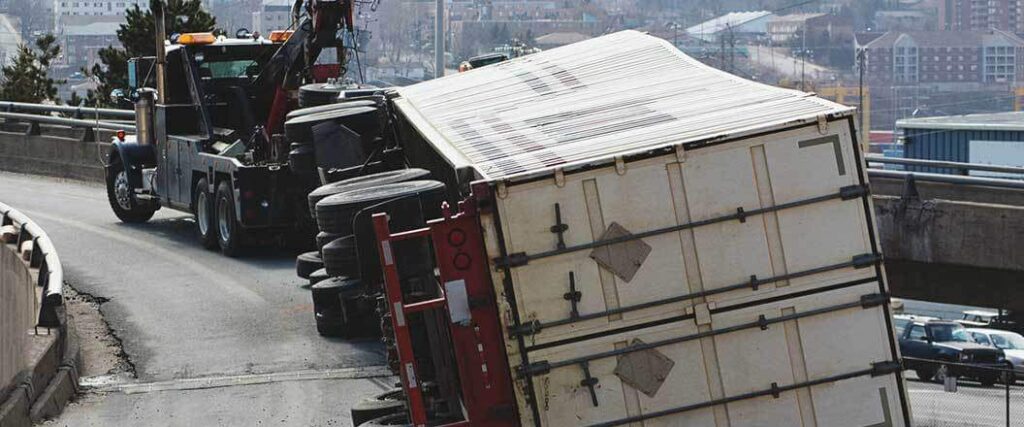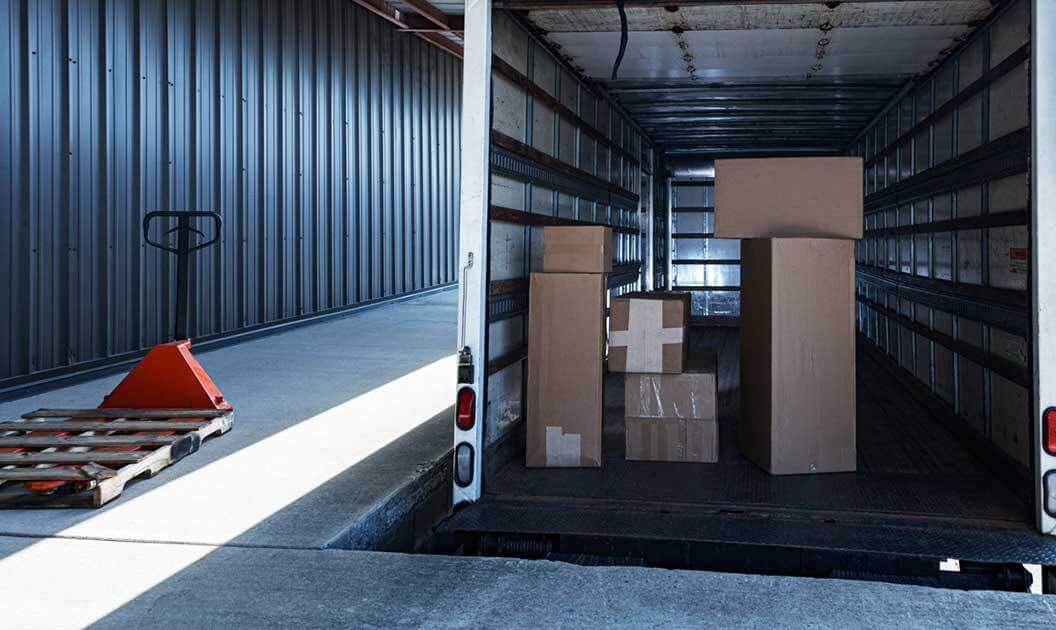Damage during transit happens even when boxes and pallets follow every best practice for safe shipping. A sudden stop or unexpected sharp turn can cause freight to shift. Sometimes a driver can tell, and sometimes it’s only apparent when the truck arrives to make its delivery. In any case, every driver should have a plan when faced with this problem.
The Code of Federal Regulations (CFR) only has a law about handling damaged class 1 explosive freight. All other transit-damaged freight is regulated by state laws or by carrier and receiver policies. A driver may be able to take shifted loads or unstable pallets to a rework warehouse for repair to make delivery possible.
Find out what your options are when your shifted load is risking rejection at delivery and how freight rework solutions can help.

What Happens If A Shipment Gets Damage During Transit?
There are different levels of damaged freight. Sometimes damage means a total loss because the items can’t be sold. Other times, it only means that loads have shifted to the point where they can’t be safely unloaded.
In either case, the first thing a driver or receiver should do when realizing a shipment is damaged is to make a record of it.
Dealing with damaged freight means dealing with freight insurance and the claims process. Said process is much easier to handle when there is clear documentation.
When dealing with product damage, receivers do the following:
- Take photos of the damage that is visible
- Add a note of possible concealed damage on the Proof of Delivery (POD)
- Get in touch with the freight broker if redelivery is needed
- File a claim with your cargo insurance provider
Even if it’s possible to repair a load through reworking, this documentation process is necessary. The receiver doesn’t have to reject the freight to file a claim. If boxes on a pallet shifted enough to need adjustment, there is a good chance of some product damage.
On the driver's side, it’s equally important to document the damage. Drivers carry their own insurance in case of damaged deliveries, especially if they are owner/operators. A claim made against a driver could otherwise have disastrous financial consequences.

Who is Responsible for Damaged Freight?
A damaged freight claim will most likely list the carrier as the one responsible for lost or damaged freight. If the carrier is an owner/operator, then technically the driver is held responsible.
When it comes to legal action, the carrier more than any other involved party has to comply with certain laws. CFR 49 § 385.5 outlines the Safety Fitness Standards for commercial transportation and it only applies to motor carriers.
These standards are meant to minimize risk by tracking activity in the following areas:
- Driver training
- Financial support
- Appropriate vehicle use
- Safe vehicle standards
- Accident records
- Vehicle maintenance records
- Hazardous material transportation
The Federal Motor Carrier Safety Administration (FMCSA) requires all carriers to carry minimum liability coverage. Frequent shippers should be familiar with this policy as well as its limits. Because of all the legal responsibilities they already have, carriers will almost never file a claim when damage occurs. To do so would be to admit they are not compliant with safety laws.
Even if the carrier is responsible - it is the responsibility of the shipper or receiver to file the freight claim forms.
Once a freight claim is investigated, they might reveal that it was actually poor packaging from the supplier or some other cause. Either way, it only gets resolved if the claims are filed.
What is a Load Shift in Trucking?
Safety laws and cargo insurance keep existing side by side because accidents can and will happen. A frequent cause of both freight damage and trucking accidents is load shift.
In trucking, a load shift is when freight in a dry van or on a trailer unexpectedly changes position from how it was originally secured.
When this happens, it can throw off the balance of a trailer and put the cargo, driver, and anyone else around in danger. During transit, an unbalanced load can even cause a trailer to flip or jack-knife.
Sadly, deaths related to commercial truck accidents have actually risen compared to the previous decade.
Deaths In Commercial Truck Accidents
| Year | Recorded Fatalities |
| 2015 | 598 |
| 2016 | 662 |
| 2017 | 680 |
| 2018 | 677 |
| 2019 | 680 |
| 2020 | 608 |
Although there is no data that tells us how many of these were related to load shifting incidents, it's a common enough problem to likely represent a significant portion.
The good news is that there are services that exist to help drivers work in safer and more stable environments.
What Causes Load Shifting?
There are entire companies dedicated to loading and securing freight. Called lumper services, or a third-party loading service, they are used just for loading and unloading.
Truck drivers are often trained in proper loading practices, but in some cases they have very little control over the loading process.
A shifted load can be caused by a number of different factors.
- Improperly loaded trailers
- Drivers forced to stop suddenly
- Safety straps breaking or loosened
- Changes in terrain
- Poorly balanced pallets
If cargo is being shipped through a Less than Truckload (LTL) service, a load shift is even more possible. Freight in LTL trailers is often moved around from stop to stop and each touchpoint represents another chance to forget to tie something down.
Proper load management can reduce load shift risks. Regularly inspecting tie-downs and making sure that pallets are balanced goes a long way toward making sure freight remains secured through all kinds of traffic conditions.

What To Do When Your Load Shifts
As a driver, you may realize you’re carrying a shifted or unbalanced load before it becomes a problem. Whether it’s because of the way the truck is handling, or at a routine inspection at a truck stop, it’s a problem that needs to be fixed.
If the problem isn’t affecting vehicle or trailer performance, you could continue on with the delivery. Most places will still accept the damaged freight, especially if it’s only a small part of the entire trailer. Refusing to accept the freight means the receiver can’t file for a damage claim and they might be on the hook for other fees.
If a receiver refuses the freight or chooses not to pay the freight bill, they also need to deal with the following:
- Storage and processing costs from the carrier
- Triggering an insurance clause that removed the provider from financial responsibility
- Denial of a claim resolution due to missing a paid freight bill
- Risk additional damage in storage
In the long run, a company that accepts damaged freight is more likely to get financial compensation for it. This is why cargo and freight insurance exists.
However, there are times when either the load has shifted in a way that presents a danger, or the destination simply doesn’t have the right equipment to move damaged cargo.
If it’s necessary to adjust or repair the cargo load, it’s best for the driver to look for a local rework warehouse. These warehouses specialize in helping drivers and carriers resolve issues with rejected loads and dangerous cargo shifts.
For more information, check out our article on rejected freight and how it affects drivers.

What is a Freight Rework Warehouse?
A freight rework warehouse is a location where drivers can go to have shifted loads and damaged pallets adjusted and repaired for acceptable delivery.
These warehouses are often located near major distribution hubs or in large metropolitan areas that receive frequent deliveries. Many also function as cross dock locations so they have the needed equipment to handle damaged freight safely.
Services offered at a freight rework warehouse include:
- Pallet repacking and wrapping
- Palletizing loose freight
- Adjustment of shifted flatbed or floor-loaded freight
- Cross docking
- Freight transload
- Short-term storage
Both truckload and LTL shipments can benefit from freight rework services to both improve their rate of delivery and avoid damaging fees because of rejected loads and redelivery fees.
Resolve Transit Freight Damage With Transload Services USA
When you have damage during transit, call the rework specialists at Transload Services USA. We want to help you resolve rejected freight issues in a way that gets you safe and back on the road fast.
Our team has decades of experience in freight logistics and the right equipment to handle any load, big or small.
We offer additional services including:
For services that are second to none and designed to keep your business on the go, trust the experts at Transload Services USA.
Call us today at (352) 282-4588 to speak with a freight specialist. Need immediate help? Fill out this form and tell us what you need right away.

